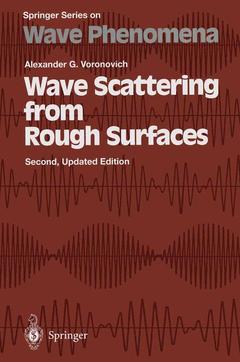Description
Wave Scattering from Rough Surfaces (2nd Ed., 2nd ed. 1999. Softcover reprint of the original 2nd ed. 1999)
Springer Series on Wave Phenomena Series, Vol. 17
Author: Voronovich Alexander G.
Language: English
Publication date: 09-2011
236 p. · 15.5x23.5 cm · Paperback
236 p. · 15.5x23.5 cm · Paperback
Description
/li>Contents
/li>Comment
/li>
Since the fIrst edition of this book was published in the 1994, the theory of wave scattering from rough surfaces has continued to develop intensively. The community of researchers working in this area keeps growing, which provides justifIcation for issuing this second edition. In preparing the second edition, I was challenged by the problem of se lecting new material from the many important results obtained recently. Even tually, a new section was added to the central Chap. 6 of this book. This sec tion describes the operator expansion technique put forward by M. Milder, which conforms well with the general approach adopted in the book and which to my mind is one of the most promising. Remote sensing of the terrain and ocean surface represents one of the most important and interesting challenges to the theory of wave scattering from rough surfaces. Rapid progress in electronics results in sensors with new capabilities. New powerful computers and data communication systems allow more sophisticated data processing techniques. What information about soil or air-sea interaction processes can be obtained from gigaflops of data streaming from air-or space-borne radars? To use this information efficiently, one cannot rely entirely on heuristic approaches and needs adequate theory. I hope that this book will contribute to progress in this important area.
1. Introduction.- 2. Scattering Amplitude and Its Properties.- 2.1 Formulation of Problem and Some Auxiliary Relations.- 2.2 Scattering Amplitude.- 2.3 Reciprocity Theorem and Unitarity Condition.- 2.4 Scattering Amplitude for Statistical Case.- 3. Helmholtz Formula and Rayleigh Hypothesis.- 3.1 Helmholtz Formula.- 3.2 Rayleigh Hypothesis.- 3.3 Analytical Properties of Surface Sources Density Function.- 3.4 Rayleigh Hypothesis and Lippman Argument: Completeness of Set of the Plane Waves.- 4. Small Perturbation Method.- 4.1 Dirichlet Problem.- 4.2 Small Perturbation Method and the Rayleigh Hypothesis.- 4.3 Neumann Problem.- 4.4 Scattering of Electromagnetic Waves at a Perfectly Conducting Boundary.- 4.5 Scattering of Sound Waves at the Interface Between Liquid Half-Spaces.- 4.6 Electromagnetic Wave Scattering at the Interface Between Two Dielectrics.- 5. Kirchhoff—Tangent Plane Approximation.- 5.1 Tangent Plane Approximation.- 5.2 Kirchhoff Approximation.- 5.3 Corrections to the Kirchhoff Approximation: Deterministic Case.- 5.4 Corrections to the Kirchhoff Approximation: Statistical Case.- 5.5 Two-Scale Model.- 6. “Nonclassical” Approaches to Wave Scattering at Rough Surfaces.- 6.1 Small Slope Approximation.- 6.2 Small Slope Approximation and Rayleigh Equation. Numerical Experiments.- 6.3 Phase Perturbation Technique.- 6.4 Phase Operator Method for Dirichlet Problem.- 6.5 Meecham—Lysanov Approach.- 6.6 Relation Between Bahar’s Full Wave Approach and Small Slope Approximation.- 6.7 Operator Expansion Method.- 7. Waveguide with Statistically Rough Boundary in Noncorrelated Successive Reflections Approximation.- 7.1 Directional Source in the Waveguide with Rough Boundary: General Solution.- 7.2 Average Field.- 7.3 Correlation Function of the Field.- 7.4 RadiativeTransport Theory.- 7.5 Problem of Noise Surface Sources: Diffusion Approximation.- References.
This edition includes the analysis of a new method, the Operator Expansion Method by Milder
© 2024 LAVOISIER S.A.S.





